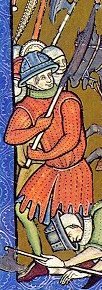Gambeson

A gambeson (also Gambison , French gambesson ) is a piece of textile armor that either consisted of several layers of linen or was stuffed with various materials such as raw cotton or scraps of fabric. Both versions were quilted. As experiments by the Association for Renaissance Martial Arts ( ARMA ) show, the gambeson could even offer good protection against sword blows, but not against stings.
The Gambeson was of knights or horsemen as part of the armor under the chain mail worn, but also by soldiers correspondingly thicker as primary armor.
In the German-speaking world, the gambeson was originally called Sarrock , the manufacturers of this textile armor were called Sarroxwewer or Sardoichsmechger (Cologne).
The chain mail, on the other hand, was called Sarwat ; the tank makers were called Sarwürken (Nuremberg) or Sarworter (Cologne). These terms probably originate from the Middle East, so they probably came to Europe during the course of the Crusades .
The gambeson or sarrock was occasionally worn over chain mail. Theodorich von Lichtenhayn had himself immortalized on his grave image in the Erfurt Predigerkirche (1366) in Gambeson and Brünne.
Especially in connection with the chain armor, the gambeson was evidently an effective protection against the medieval long-range weapons (bow and crossbow), especially at greater distances. In modern fire tests , the arrow or the bolt usually penetrated the chain mail, but got stuck in the gambeson.
Evidently from the 15th century onwards, the gambeson was gradually displaced by the brigantine (from brigant: war servant): Small armor plates made of metal or other robust materials were sewn between the layers of fabric or leather. The high medieval plate skirt is often seen as the forerunner of this intermediate stage of textile armor and armor .
See also
Web links
Individual evidence
- ↑ Testing Blades and Materials (videos starting with Norman ).
- ↑ Kurt Martin, Theodor Müller: Studies on the history of European sculpture: Festschrift, Theodor Müller, on April 19, 1965 . Munich, Hirmer, 1965, p. 79